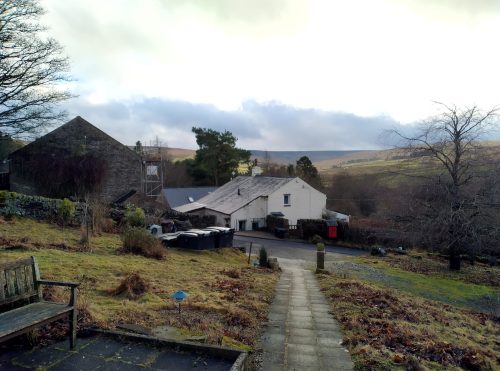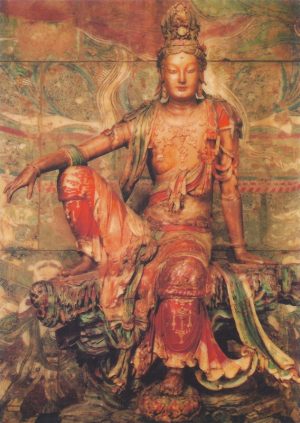February 2023 Newsletter
Funeral for Alan MacCormick
On the 13th of January we held a funeral for Alan MacCormick, who was a very long established member of our Nottingham Meditation Group, and a great supporter of Buddhism throughout the East Midlands for many decades. Alan died in mid-December, and his funeral was held at Gedling Crematorium in Nottingham. The photo below is from the funeral booklet.
The funeral was very well attended, with perhaps 80 to 100 people in attendance, including family members, friends and work colleagues of Alan, and many members of the Nottingham Meditation Group. There were several Sri Lankan Buddhists from the Leicester Buddhist Vihara there too, as in the 1980s Alan was a founding trustee of the charity which supports their temple. The crematorium was so full that there were rows of people standing at the back throughout the service.
Rev. Aiden was the celebrant for the ceremony, together with Rev. Alicia from Sitting Buddha Hermitage in Derbyshire. The ceremony is an ordination ceremony to the Buddhist Sangha, and is based in the giving of the Buddhist Precepts, just as is done in the ceremonies of Lay Ordination and Monastic Ordination.
During the ceremony Alan’s son, daughter and son-in-law offered moving remembrances of Alan and his life, helping give a more rounded sense of him to those who perhaps only knew Alan through one of his many interests and activities.
Alan attended one of the first retreats in the UK given by Rev. Master Jiyu-Kennett, the founder of our order, and over the years many monastic and lay trainees came to Buddhism through the meditation group that met at Alan’s house and elsewhere. We are very grateful to Alan for his practice, and for all his support of Buddhism over many decades. It was lovely to have so many people attend his funeral so that we could give him a fitting send off, and offer our gratitude for his life of practice.
Forthcoming Events:
The Festival of Avalokiteshwara Bodhisattva
On Saturday the 4th of February we will be celebrating the Festival of Avalokiteshwara, the Bodhisattva of Compassion. The name Avalokiteshwara is Sanskrit (Japanese: Kanzeon, Chinese: Kwan Yin, Tibetan: Chenrezig), and means “The one who hears the cries of the world”. To live with compassion is to hear the cries of suffering within ourselves and within all beings, and to be willing to respond, and the festival will focus on this centrally important aspect of Buddhist practice.
During the festival a wide variety of different images of Avalokiteshwara are placed around the walls of the meditation hall, and we circumambulate the hall and bow to each image as we pass it. This symbolises the fact that compassion can appear in many different forms, sometimes in a way that we least expect, and that if we want to know stability and contentment in our lives we must accept, and bow to, all these different appearances of the nature of reality. This is one way in which we ourselves express compassion for all living things.
In addition to welcoming visitors to the temple for the festival (please book in advance), we will also be holding the festival over zoom so that Lay Sangha members can join in from where they are. Full details of the festival day will be sent out by email to Lay Sangha members prior to the festival.
This festival day will run from 10am to 4pm, with the Festival and Dharma Talk both in the morning so that people can come just for those if they would prefer. There will then be the option to stay on for a bring-and-share lunch and an afternoon of meditation, followed by tea and biscuits and an opportunity to ask questions.
Visit to Throssel Hole Buddhist Abbey
by Rev. Aiden
Throssel Hole Buddhist Abbey in Northumberland is our order’s main monastery in the UK, and it was very nice to have the opportunity to visit during January. It was good to see all of the community again, including Rev. Master Berwyn who has recently been elected as the Abbot. It was also lovely to see Rev. Master Daishin who was staying at Throssel during January as well.
Throssel usually gets a fair amount of snow over the winter, but this year it was mostly damp and windy whilst I was there. The photo below shows the view up the valley on a mild blustery morning, with just a little brightness on the tops of the hills.

The community at Throssel have been looking into ways of cutting down their energy bills, and are starting to have photo-voltaic solar panels fitted to some of the buildings. The first one to be done will be the monks’ Meditation Hall, and the photo below shows the scaffolding that has been put up in the courtyard next to the building to allow the panels to be installed. Unfortunately, bad weather and other delays meant that they hadn’t yet been installed by early January, but hopefully work will be able to start before too long.

During January Rev. Master Daishin gave some Dharma Talks to the community. It was lovely to be able to join in with two of these meetings whilst I was there, and to join the remaining ones via zoom once I was back in Leicester.
Buddhist Stories
There are many stories in Buddhism, from the time of the Buddha onwards, and they are very helpful in illustrating aspects of the Buddha’s teaching and Buddhist practice.
Fishing with a straight needle
In Buddhism we don’t try to convert people, or persuade them that they ought to practise. The motivation to engage with Buddhist practice has to come from each of us individually, and no-one else can give that to us. This story is a metaphor for how Buddhism is passed on to other people, both from the perspective of the teacher and of the student.
The story is from the foreword to a book of teaching by the Japanese Rinzai monk Sokei-an Sasaki, who first came to the US in 1906 and ended up living in New York from the early 1920s until his death in 1945.
For forty years a fisherman in China used a straight needle to fish with. Of course, people found that rather odd, and asked him why he didn’t just use a regular bent hook like everyone else, as he might catch a few more fish that way! When he was asked this, the fisherman replied, “You can catch ordinary fish with a bent hook, but I will catch a great fish with my straight needle.”
Who knows what people made of that? The fisherman, however, wasn’t concerned with what they thought. He still just kept on fishing with a straight needle, and word got around, as word often does get around of people who are doing ‘interesting’ different things. He gradually became quite famous in the region he lived in, not just in the neighbouring villages, but even in the bigger towns and cities, where most people had heard about this fisherman out on the coast who was sitting there fishing with a straight needle.
As the years and decades went by his fame grew and grew, just by word of mouth. Eventually, after about forty years, his story came to the ear of the Emperor, who was intrigued by the story and decided to pay him a visit. The Emperor wanted to see this ‘fool of a fisherman’ for himself.
When the Emperor finally managed to track down the fisherman, and find out exactly where he was, he sat down next to him and asked him what he expected to catch, fishing with this straight needle. The fisherman turned to the Emperor and said, “Emperor, I have caught you!”
***
This is a really nice story, and appearing as it does in an introduction to a book of Buddhist teaching, it is a metaphor for the fact that we ourselves must bring ourselves to Buddhist practice. We come voluntarily — no-one is trying to get us on a hook, or reel us in. It’s important to realise that the metaphor isn’t actually about fish willingly impaling themselves on a straight needle, it’s about the relationship of the Emperor to the fisherman.
The fisherman hasn’t contacted the Emperor, or asked anyone else to contact the Emperor. All he has been doing is this apparently stupid thing of fishing with a straight needle. It’s neither here nor there whether it’s actually a really stupid thing or a clever thing; it is the fisherman’s practice and he is just getting on and doing it, and isn’t trying to entice or attract the Emperor or anyone else.
Word of him fishing with a straight needle just gradually gets around. Maybe lots of people went along to see him, but probably the vast majority just heard about it and laughed, and didn’t bother going to see him.
But when the Emperor heard about it, he made time in his busy schedule to go and see the fisherman for himself. And that’s how it is for us; we have to make time for Buddhist practice in our life. The Buddha isn’t trying to reel us in. We don’t try to convert people; we each have to come to it for ourselves.
In Sokei-an’s introduction, after relating the story he comments: ‘If you have no experience in fishing with the straight needle, you cannot understand this story. Simply, I am holding my arms on my breast. Like that fisherman with the straight needle, I fish for you good fishes. I do not circulate letters. I do not advertise. I do not ask you to come. I do not ask you to stay. I do not entertain you. You come, and I am living my own life.’
That’s how it is with Buddhist practice; we don’t try to convert anyone else and we don’t try to convince anyone else. Buddhism spreads just by us doing our practice, just as in the story the fisherman is just fishing with a straight needle, not trying to catch anything.
If it took 40 years for the Emperor to come along and see the fisherman, you could certainly ask the fisherman, ‘was it really worth it?’ Sitting out in the wind and rain for 40 years, just to have a two minute conversation with an Emperor. But the fisherman could answer, ‘well I was just doing my own practice. I was going to do it anyway, and actually I didn’t have any expectations of anyone coming along to see me, whether or not they were an Emperor.’ And that is how it is with our Buddhist practice too.
You could argue that the fisherman actually did have an expectation, as he said, ‘but I will catch a great fish with my straight needle’, but that phrase just has to be in the story in order to set up the punchline. If the fisherman was always wondering whether the Emperor was just about to turn up then he wouldn’t have been able to keep going for forty years. And perhaps what the Emperor represents is that after all these years of practice, the fisherman sees things clearly and understands the Life of Buddha. The meeting with the Emperor can at the same time represent both ‘people coming to find out about the practice’, and also ‘the fisherman himself meeting Buddha’.
Similarly, when Sokei-an says, ‘Like that fisherman with the straight needle, I fish for you good fishes’, that can’t mean ‘in order to catch you’, because the whole point of the straight needle is that there is no intention to catch. ‘For you good fishes’ must mean ‘for the benefit of you good fishes’, and as he can’t know who those good fish are, it is actually ‘for the benefit of all beings’, including himself. This is the Bodhisattva vow in action: ‘I wish to unfold the Buddha’s teaching, that I may help all living things.’
When Sokei-an says, ‘If you have no experience in fishing with the straight needle, you cannot understand this story’, this doesn’t mean that we have to be a Buddhist teacher to understand it, we just need to have had the experience of coming to Buddhist practice of our own volition, just as the Emperor came to the fisherman. If we have been in the position of a trainee then we will be able to understand, because we know what it is like to not be ‘hooked and reeled in’, but to willingly bring ourselves. It’s our own volition, our own wish. It’s us who want to practice, and no-one is trying to convince us of that.
In terms of religion or spiritual practice, if people are trying to convince us of things, then that is often a warning sign; it’s generally better to find someone who is just doing their own practice rather than trying to attract followers. Of course our Buddhist practice isn’t ‘just doing our own thing’ in the sense of being based on our own views and opinions, it is the Buddha’s practice. And even the Buddha said that it wasn’t ‘his own thing’; it was a timeless truth that he had found, not something he had invented.
He just got on with his practice, and people heard about it and were interested, and came along to join in. That’s how Buddhism has carried on for 2,500 years.
There is also a story from the time of the Buddha which relates to this story, as it addresses the question of ‘what about all those that didn’t come along?’. One day someone came to see the Buddha and asked him, ‘Is your teaching for everyone? Can it benefit everyone?’ The Buddha didn’t answer the question, which must have seemed strange to the visitor, but afterwards the Buddha’s disciple Ananda explained to the visitor why the Buddha hadn’t answered; it is because the Buddha’s practice is to offer the teaching to anyone who comes along and is interested. Those who don’t come along are not his concern; it is up to them what they do, but if they don’t choose to engage with the teaching then the Buddha isn’t in a position to offer the teaching to them, and he doesn’t try to force it on them. This is the Buddha’s offering to all those who don’t come along, as it allow each person the time and space to come to it for themselves; they are not forced to engage at a time when perhaps they won’t really understand or connect with it.
***
The story is a very important metaphor for us bringing ourselves to Buddhist practice. We come to practice because that is what we want to do, not because we are being enticed or hooked or reeled in. Even though it is a very short story, this is an important teaching to reflect on; to realise that we must bring ourselves to practice, and that our practice is always our own responsibility.
Whether teachers are present or absent, whether teachers are saying good and helpful things or not, it is always down to us to do the practice. And if we are doing the practice then we will hear the teaching, because the teaching is always there to be heard in the world around us, if we are paying attention. We must bring ourselves and engage with it.
Sources:
The story is from the foreword to a book by Sokei-an Shigetsu Sasaki (1882-1945), who was the first Zen master to settle permanently in America.
Alms Bowl Requests
Donations of Food
Offering food is a traditional way to support a monk, and all donations of vegetarian food are most welcome. In particular:
- porridge oats
- peanuts or other nuts
- peanut butter
- fresh fruit and vegetables (except garlic or peppers)
- dried herbs
- cheese, eggs and yoghurt
Any other suitable items would also be appreciated.
Donations
The temple is dependent on donations for its continued existence, and any financial support you are able to offer is greatly appreciated. Details of how to offer support can be found on the Donations page of the website.
All donations are received with gratitude





